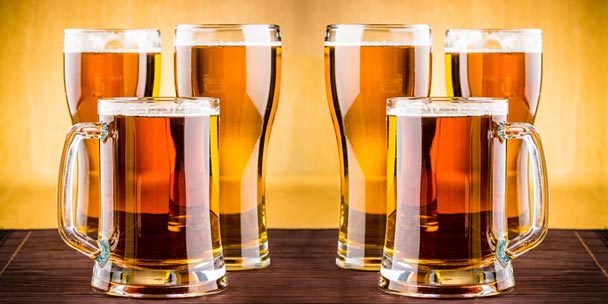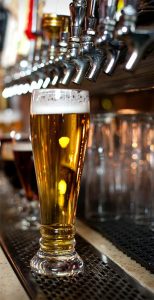
You’ve had a rough day at work, and nothing sounds half as good to you as opening the first bottle of your newest batch of IPA. You get home, open your fridge, and pull out your treasured treat.
As you open the bottle, you hear the satisfying hiss of a perfectly carbonated beer. You hold the bottle to the light and see the bubbles already forming, appetizingly rising to the top to carry the aroma to your nose. You know you can look forward to a nice frothy head at the top of your beer.
You pour down the side for half of the glass and then straight down the middle, just as you know you’re supposed to. There’s only one problem: No head is forming.
What happened? There are bubbles in the beer, but they never accumulate at the top. The aroma of the beer seems diminished, and there are bubble clinging to the sides of the glass’s interior.
Oh, no. The glass is not completely clean.
Sure, it looks clean, but while there may be no visible residue on the glass, there can still be some residual oils, sugars, or detergent clinging to the inside of the glass (and now floating around in your beer) that are dampening your beer drinking experience. It may look clean, but it isn’t “beer clean”.
What is “Beer Clean”?
A “beer clean” glass is a glass that is clean enough not to diminish the beer drinking experience. It does not take much residue to cause head retention and aroma problems in a beer. A small amount of sanitizer, detergent, or oil can make a significant difference in the perception of the beer being poured in it.

The main issues you will encounter with a glass that is not beer-clean is residue inside the glass. Typically, residual oils and sugars, such as from milk or soda, can cause head retention problems while residual detergents or dust can create unwanted nucleation sites and similarly cause head retention problems.
This is a common problem in bars. You can tell if the bar you are visiting takes their beer seriously by the way they treat their glassware. A good beer bar will always ensure the beer glasses are clean by doing each of the following.
1. Have Dedicated Glasses for Beer
They dedicate the beer glasses for beer and stick to it. If the bar you’re at uses the same glass to make a white Russian or serve a soda and then to serve a beer, they are making a mistake. The oils and sugars from other beverages will remain behind even after the glass appears clean.
2. They use a good glassware detergent
At home, you can use baking soda or salt if you have a lot on hand. Commercially, Barkeeper’s Friend is a good cleaner that uses oxalic acid. It’s abrasive, but doesn’t harm the glass and is very effective. It cleans stainless steel very well, too.
3. They rinse very thoroughly
They have to do this to make sure they get all of the detergent off of the glass. In a commercial setting, bartenders should change their rinse water often, if it is not constantly flowing.
4. They choose the right sanitizer
In many states and cities, commercial enterprises are required to also sanitize their dishes wither with heat or with a chemical sanitizer. If they have the option, a great beer bar will always go with heat. If it is not an option or if it is not practical, a good bar will try several sanitizers until they find one that doesn’t leave a residue and that does not affect the aroma or flavor of the beer.
5. They are careful with sanitizers
Most of the laws involving sanitizers require no-rinse sanitizing, which means that there will always be a small amount of sanitizer left on the glassware. In addition, when a bar is sanitizing glassware, they should always use the correct amount. Too little will not sanitize properly. Too much is no more effective, but leaves unwanted residue.
6. They rinse before pouring
If possible, a good beer bar should always rinse the glass with clean, cold water and drain right before pouring. This will help rinse out any residual detergent, but it will also eliminate any dust which may have landed in the glass since it was last washed. In some jurisdictions, rinsing after sanitizing is a no-no, so this depends on the health code in which a commercial venture is located, but there is no reason you should not do this at home.
How can I tell if my glass is really “beer clean”?
A glass that is not beer clean will seem to have a sudden loss of head after pouring and will not experience proper lacing down the side of the glass. Lacing is the effect you get as you drink a beer where the residual bubbles stick to the inside of the glass. The effect is the appearance of lace, hence the name.
To really tell the difference between a beer clean glass and one that has residue, let’s deliberately create the difference through an experiment:
Get two identical glasses from your cabinet. Pour a small amount of milk in one and rub it on the inside of the glass, then rinse it out. With the other one, add a small amount of water and some salt or baking soda. With your hand, “scrub” the inside of the glass with the baking soda or salt, then rinse it out very thoroughly.
Now, pour the same beer the same way in both glasses. In the scrubbed and thoroughly rinsed glass, you should have a much better head which leaves lacing on the side as it dissipates.
In addition, you should not see bubbles sticking to the side of the glass under the surface of the beer. In the milked and rinsed glass, you will see some head retention problems at the very least, and possibly some bubbles clinging to the sides of your glass or nucleation sites where bubbles are being created along the sidewalls of the glass.
If you then smell the aroma of the beer, you’ll find the beer clean glass carries more of the aroma to your nose. And aroma is very important. A large part of what we taste is actually perceived by our sense of smell.
This is a deliberate way to illustrate how oils and residues can adversely affect the pour of your beer, and you don’t need much in the glass to get this result, which is why you can rinse the milk glass and still see this happen.
To see if your glassware is getting beer clean in your dishwasher or in your sink at home, try another experiment with identical glasses again. This time, don’t add the milk. Take the glasses out of the cabinet and wash one glass with the baking soda or salt and just rinse the other glass.
Pour the beer in both glasses. If your dishwasher or cleaning methods are not getting your glasses beer clean, you will still see a noticeable difference.
3 Simple Steps to Cleaner Beer Glasses
The best way to make sure your glassware is always “beer clean” is to follow three simple steps:
- Always reserve your beer glasses for beer. Never serve any other beverage in them.
- Always rinse and clean your beer glasses immediately after use. Don’t let beer concrete set in the bottom.
- Always rinse your glass with cold clean water immediately before use. This will make sure any dust that has settled has been rinsed out.
That’s it. It’s a very simple way to make sure you show your beer the proper respect. Respecting your beer will ensure that you get the best experience you can every time, and that’s especially important when the beer is your homebrew.
Original Post from: https://learn.kegerator.com

Leave a Reply
You must be logged in to post a comment.